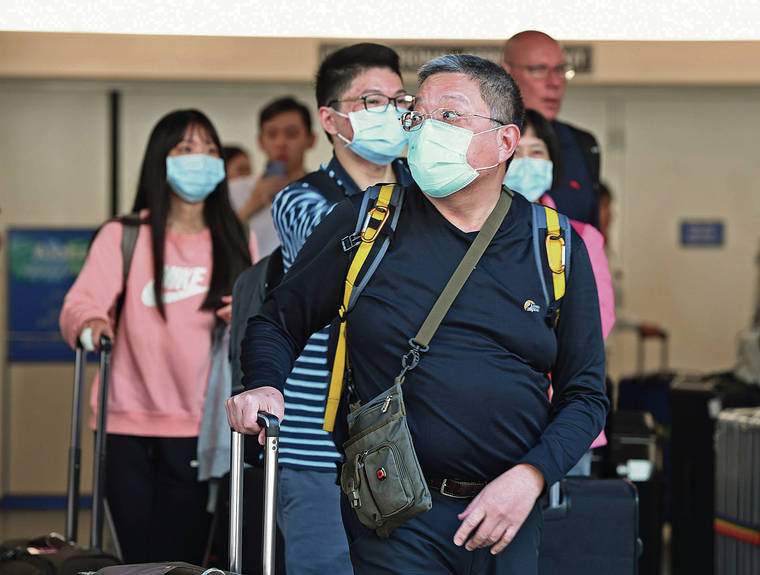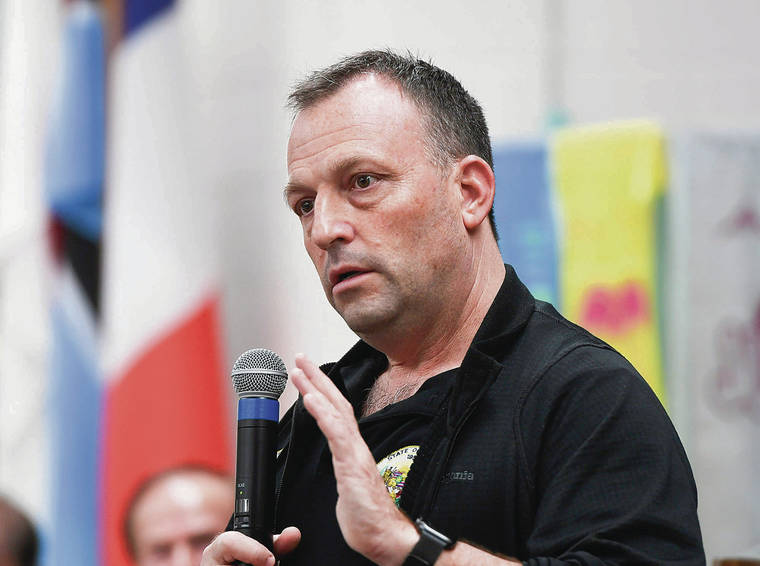Hawaii Lt. Gov. Josh Green wants random coronavirus testing for arriving passengers

BRUCE ASATO / BASATO@STARADVERTISER.COM
The state is considering randomly testing visitors to Hawaii for COVID-19. Travelers left the individual customs area wearing their masks at Daniel K. Inouye International Airport in February.

STAR-ADVERTISER
Josh Green:
The lieutenant governor says Hawaii can’t require COVID-19 testing as a condition of entry


One in every 20 passengers to Hawaii might be asked to take a random COVID-19 test if state leaders accept a plan being pushed by Lt. Gov. Josh Green.
Green, who said he planned to present details about the concept to state leadership today, is proposing that the state use some of its $50 million federal CARES Act testing funds to begin randomly testing visitors for COVID-19. Ideally, Green said he’d like to start the random testing program to coincide with the June 16 lifting of the mandatory 14-day self-quarantine for interisland passengers.
Gov. David Ige announced the coming end of the interisland quarantine on Monday and said interisland travelers would still be required to undergo health screenings and temperature scans at airports and complete additional paperwork on travel history, residence, and where they will be staying on-island.
“I’ll be proposing random testing, optional, so that we can have rolling numbers day over day, week over week, to know that we have very low positive rates coming into our state,” Green said. “My hope is about every 20th person would get a test and we would thank them with a gift of aloha —something to show appreciation for their helping keep us safe.”
Green envisions that the state Department of Health and the state Department of Transportation would work together to establish airport protocols for the random testing, which would complement the state’s other passenger entry programs including temperature checks.
He’s advocating for nasal swab testing, with the caveat that those tests could be replaced if something more convenient is approved that’s just as reliable.
Don't miss out on what's happening!
Stay in touch with breaking news, as it happens, conveniently in your email inbox. It's FREE!
Travelers could be randomly selected for testing through the mandatory state Department of Transportation entry forms that they fill out, he said.
“We are expanding our state’s surveillance system to include all travelers,” Green said. “If they have an extra red mark on the form, they would get the extra screening. We would have extra personnel at the airport to do the testing such as AMR (American Medical Response).”
Green said Hawaii would not be able to require the random testing of passengers as a condition of entry, but expects some visitors will consent.
“You’re not allowed to require testing of anyone anywhere. The leverage that we’ve had on people historically is the quarantine,” he said.
In the past, Green has proposed making a clean COVID-19 test a condition for exempting passengers from the quarantine. The out-of-state quarantine expires June 30, but Ige said Monday that he would announce a target date next week for when trans-Pacific travel can resume.
Green said he’s still promoting the idea that travelers get tested before they come to Hawaii. However, in the interim, he believes that random testing would allow the state to better assess travel-associated risks of COVID-19.
“It’s a broader discussion about what our recommendations are whether we would require testing in advance of travel like Alaska has proposed,” Green said. “But we are waiting to decide some of those things. For now comprehensive screening will suffice to get into Hawaii, but adding this active surveillance testing will make us a lot safer and give DOH and other leaders real data to continuously reflect on as we reopen the state.
Mufi Hannemann, president and CEO of the Hawaii Lodging & Tourism Association, said random testing could be a way to bring Hawaii one step closer to lifting the passenger quarantine that has collapsed tourism.
“Obviously in a perfect world, we want everyone tested. But we now understand that it isn’t yet possible,” Hannemann said, after hearing about Green’s plan. “Therefore random testing makes a lot of sense. Contact tracing will be very important, too. We can’t keep quarantining healthy people.”
Arrivals rising
The random testing idea comes as the rest of the world’s travel destinations have started reopening, including Las Vegas. While demand for Hawaii tourism is still low due to passenger quarantines, daily arrivals have been rising some.
Hawaii Tourism Authority said Wednesday that 419 visitors came to Hawaii on Tuesday on 19 flights. The count dipped below Monday’s 462 visitors, which was the highest level since the trans-Pacific quarantine began on March 26.
Visitors made up about 26% of the 1,587 passengers that arrived in Hawaii on Tuesday. Altogether there were also 480 returning residents, 147 airline crew members, 203 military members and 159 people that planned to relocate to Hawaii. There were 126 transit passengers who didn’t plan to leave the airport and another 53 people who had gotten permission to be exempt from the quarantine.
Most of the visitors, some 357, traveled to Oahu. Maui had 39 visitors and Kona 23.



